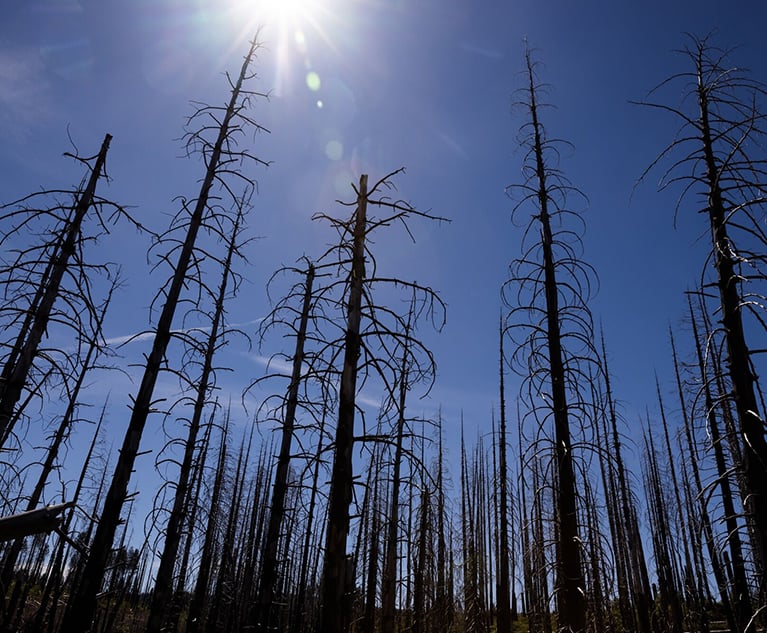In the spring of 2000 when your Iconoclast was still editor ofthe CPCU Claims Quarterly (CQ), a very typical situation foreditors of such publications occurred: articles that had beenpromised for the July issue were not forthcoming. When the deadlineis near and the material is not, editors tend to dig deep among thepress releases for something useful, but if all else fails, theywrite a long editorial. Mine was entitled “Wilderness Search andRescue – An Underwriting Opportunity?”
|In it were statistics cited from the American Alpine Club that,in 1998, search-and-rescue costs represented 15 percent of thetotal budget of the National Park Service. When one added the costof Coast Guard rescues of unqualified weekend sailors out there onthe oceans, American taxpayers are paying for the stupidity of asmall minority of our citizens. Why not make such costs a factor ofliability coverable under various insurance forms and charge thosewho want to risk their lives climbing mountains or hiking in thewilderness for special endorsements to cover the costs ofrescue?
|In short, the CQ editor and his big idea got roasted! Lettersflowed in from all over the country. Some protested that while theeditor was sitting on his big, fat butt creating expensive healthproblems, the mountain-climbing and boating athletes were out thereexercising, staying healthy, and enjoying the beauty of America.Bad idea, said others. The volunteers who rescue lost climbers doit voluntarily, and they love doing it, so mind your own business!The message was that the author of such a stupid notion ought totake a hike on the Appalachian Trail – and not come back!
|The Cost in Ranger Injury and FatalityFigures
|In the 2000 article, the National Park Service's OWCP chart for1997 was cited as showing 32 fatal injuries costing $591,750, alongwith 305 lost-time injuries at $10.84 million and 2,148no-lost-time injuries costing $4.3 million. (Apparently most of therangers who were killed on the job – 11 percent from slip-and-fallclaims that would include rescues – were single, as the then“spouse” weekly benefit was around $1,500.) Thus we taxpayers alsowere slipped this $15.7 million bill that year, along with otherrescue costs.
||A current look on the Internet, googling National Park Rangerinjuries, shows a variety of new fatalities since 1997 in many ofthe mountainous western parks. While statistically climbers now arebetter prepared, equipped, and safer, not a year goes by without anumber of mountainside rescues becoming necessary. Add to thenational park scene all those non-park peaks, like Mt. Hood (whichis in a National Forest, under the U.S. Department of Agriculture,not the Department of Interior), and the statistics show a lot ofexpenses for search and rescue. Then add the costs of open-waterrescues by the Coast Guard and other military services, aswitnessed in the docudrama movie, The Perfect Storm, and the realcost to the public becomes clearer.
|Fools and Their Money
|Boating, hiking, mountain climbing, and skiing are not thesports of the poor. It takes lots of money to buy a boat or theequipment to face a mountain cliff or a wilderness trail, and I'dbe the last to say, “Don't do it!” I envy those who are able toenjoy these sports. But if the participants can afford the cost ofthe boat or the equipment (Having visited an L.L. Bean discountstore in Maine this summer, I know what hiking boots cost!), thenthey also should have to pay for the cost of their rescue when theyvoluntarily place themselves at risk.
|The government has considered this. Public Law 106-486 wassigned into law by President Clinton on Nov. 9, 1999, requiring theNational Park Service to complete a study of search-and-rescuecosts associated with Denali within two years. It addressed therecovery of rescue costs on Mt. McKinley, requiring climbers toshow proof of medical insurance before they receive a permit toclimb, and charging for a climbing permit. The final resultsprobably were lost, as I could find nothing further about whatCongress or the DOI did about the bill, although a number ofrescue-related agencies did provide input to the study.Surprisingly, many of those agencies and volunteer groupsrecommended against higher charges for permits. (Denali Park hadbeen charging $150 per climber in 1994; increases wererecommended.)
|In 1994, the Mountain Rescue Association had adopted a policy oncost recovery that stated, “no one should ever be made to feel theymust delay in notifying the proper authorities of a search orrescue incident out of fear of possible charges…. The expertvolunteer teams of the MRA are proud to be able to provide searchand rescue at NO cost and have NO plans to charge in the future.”(The emphasis was theirs.)
||The American Alpine Club at the same time said it was “opposedto the imposition of any 'management' fee that is discriminatoryand out of proportion to the total costs incurred by the NationalPark Service” for search and rescue. The AAC suggested that suchfees could “create a legal 'duty to rescue' on the part of theNational Park Service.”
|Rescue and the Law
|In the re-written chapter on tort law in Casualty InsuranceClaims, 4th, Vol. 1 ?9:8 (Thomson-West Group, Sept. 2006) thiswriter discussed the rescue doctrine as applicable in defense of aliability claim. The doctrine is “a bar of the assumption of riskdefense…. Courts have held that a person injured during areasonable attempt to rescue another person has not assumed therisk, as that other person had negligently placed him or herself inthe dangerous situation requiring rescue. In one Michigan case(Hughes v. Polk, 199 N.W.2d 224 [1972]), the appellate court heldthat one who goes to the rescue of a person who is in imminentdanger of a serious peril, caused by the negligence of that otherperson, is not contributorily negligent so long as the rescueattempt was not made recklessly or rashly. The courts in manyjurisdictions have held similarly, although other courts have heldthat the rescue doctrine cannot be used to excuse allegednegligence.
|“Many jurisdictions apply comparative negligence in response tothe assumption of risk doctrine where the injured party sustainedthe injury while attempting to rescue another whose negligence ledto the endangerment requiring aid. As Supreme Court Justice Cardozoonce commented in a rescue case, 'danger invites rescue.' (Wagnerv. Int'l. Ry. Co., 133 N.E.437 [1921]). The doctrine is oftenenacted into code, such as California's Civil Code ?1714, holdingthat a rescuer can recover damages from a negligent victim. Thedoctrine has been found to apply in situations where the rescuerwas injured while responding to a situation in which the partybeing rescued had negligently placed himself in danger.” (Sears v.Morrison, 76 Cal App.4th 577, 90 Cal. Rptr.2d 528 [1999].)
||Adjusting a Rescue Claim
|It is not, therefore, beyond the realm of probability thatliability claims may result from rescuers who are injured in arescue attempt. These claims or lawsuits would appear to be coveredby the typical homeowners' forms, section II, unless specificallyexcluded by some special endorsement. Of course, there is the“expected or intended” injury exclusion; someone climbing amountain in the winter might well “expect” the need to be rescued,and might also “expect” that a rescuer could be injured.
|An adjuster receiving such a claim would need to respond, butalso would need to research the tort law of the applicablejurisdiction to see whether the rescue doctrine would bar theassumption of risk defense to the rescuer's claim. It is less clearthat requiring a climber to pay a fee for a permit, part of whichmight cover potential cost of rescue expenses, would create the“duty to rescue,” as the AAC suggests. Many of those costs dealwith aircraft. Undoubtedly some court will address these questionssome day.
|In the 2000 article it was pointed out that the homeowners'forms, while they might apply to claims from rescuers killed orinjured – if such injuries were not deemed to have been “expected”– would probably not cover any of the other costs of being rescued,such as the lost wages of local or federal law enforcementpersonnel, rangers, or volunteer rescuers, helicopter or similarexpenses, as those would not be deemed to be either “bodily injury”or “property damage” under a liability form. The article suggested,therefore, that for those who do desire to undertake dangerousactivities such as mountain climbing or open water boating,endorsements be made available by insurers to cover the expensesrelated to rescue. Otherwise, those costs are passed along to allof us via taxes.
|Your writer confesses that the highest “mountain” he everclimbed was “Old Agony” at Ft. Knox, Ky., during Army basictraining. But he loves mountains and our national parks, and hasbeen in most of them, including Denali, Yosemite, North Cascades,Olympic, Glacier, Teton, and Rocky Mountain, and has seen Mt. Hoodon many occasions. While he has no desire to climb them, he canunderstand the lure that such an adventure creates. But he doesresent that millions of tax dollars are being spent to rescuefoolish people who take on these ventures and then have to havevolunteers or government rangers and law enforcement personnel risktheir lives trying to rescue them. Good underwriting would indicatethat there is a viable market here for a new insurance or suretyproduct, and thus perhaps some more interesting claim work forthose of us in the adjusting business.
|Ken Brownlee, CPCU, is a former adjuster and risk manager,based in Atlanta, Ga. He now authors and edits claim-adjustingtextbooks.
Want to continue reading?
Become a Free PropertyCasualty360 Digital Reader
Your access to unlimited PropertyCasualty360 content isn’t changing.
Once you are an ALM digital member, you’ll receive:
- All PropertyCasualty360.com news coverage, best practices, and in-depth analysis.
- Educational webcasts, resources from industry leaders, and informative newsletters.
- Other award-winning websites including BenefitsPRO.com and ThinkAdvisor.com.
Already have an account? Sign In
© 2024 ALM Global, LLC, All Rights Reserved. Request academic re-use from www.copyright.com. All other uses, submit a request to [email protected]. For more information visit Asset & Logo Licensing.








